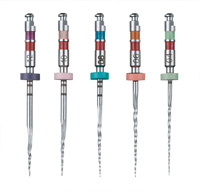Is there a place for the use of BOTOX and dermal fillers in dentistry? Should dentists be providing facial cosmetic procedures that have been commonly performed at spas and by the medical profession? Looking at the facts surrounding the uses for BOTOX may cause a paradigm shift in your attitude as a dental professional toward these treatment modalities. The purpose of this article is to introduce how and why we decided to incorporate facial rejuvenation procedures into our practice. Later articles will deal with the actual treatment procedures and other related issues in more detail.
|
|
||
|
OUR EXPERIENCE
Our family background includes those who work in the commercial fishing industry. We know from their experience that the key to success involves using the latest technology and advancements to chart their course before the changes in the tide inevitably leave them behind. Their success is dependent on this concept of continually adapting to a changing world. Recognizing that the tide was also changing in dentistry, we decided to apply the same philosophy to our dental practice and began to include facial rejuvenation into our “smile design” treatment plans. Our most exciting adventure to date has been the opening of a Facial Rejuvenation/Aesthetic Dentistry clinic, appropriately named “A Smile Above.” Since doing this, we are enjoying dentistry more than ever before.
DEFINING FACIAL REJUVENATION
Facial rejuvenation is any cosmetic, dental, or medical procedure that is used to restore a younger appearance to the human face without surgery. Facial rejuvenation comprises a number of treatment modalities. Two of the most common minimally invasive (MI) and reversible methods of treatment include the use of BOTOX and dermal fillers. BOTOX, the natural and purified protein of the clostridium botulinum bacteria, is used to cosmetically soften lines and wrinkles of the face and neck. Approximately 3 to 4 months after the initial BOTOX treatment, the affected muscles will return to their pretreatment condition. Hyaluronic acid dermal fillers are used to restore volume that is lost through the natural aging process. Nine to 12 months after dermal filler treatment, the body naturally resorbs the material.
These 2 treatments are a natural adjunct to aesthetic dentistry and their use can have a major impact on the aesthetic outcome of smile makeovers and comprehensive restorative treatment. This occurs as a result of their effect on tooth display and the draping of the soft tissue around the mouth. Even dentists who may not be inclined to provide these treatments themselves should at least consider educating themselves in how BOTOX and dermal fillers influence the dental treatment they provide.
IMPORTANCE OF PHOTOGRAPHY
As aesthetic dentistry has evolved, photography has taken on an ever-increasing role in providing optimal treatment. From cosmetic imaging that allows a patient to preview a potential course of treatment, to laboratory communication and accurate record keeping, photographs are a vital part of the process.
In the area of facial rejuvenation, patients often have difficulty understanding and communicating what they want to improve. A series of photographs that allows them to view themselves from all angles is required. As a result, we created the Roberts Facial Rejuvenation Photography (RFRP) series of 29 digital photographs. This series of photos allows patients to view themselves with various muscles activated from angles they are unaccustomed to seeing. It also helps the dentist to critically analyze the face and to demonstrate how the muscles of facial expression can affect the smile design. (A future article in Dentistry Today will be devoted entirely to the RFRP series and its uses.)
WHY SHOULD DENTISTS CONSIDER THESE TREATMENT MODALITIES?
Patients who are interested in enhancing the appearance and function of their teeth also frequently want to improve their overall facial appearance. In the past they have sought treatment for facial enhancement elsewhere. However, as dentists, we are uniquely skilled to provide these treatments for our patients. Who has better training and understanding of facial anatomy than dentists? Who is more skilled at giving injections? Who do patients trust to work in areas around their mouths? If dentists can be trained to perform delicate endodontic procedures, sinus lifts for implants, and other involved procedures, are they not capable of performing tiny injections into superficial muscles of the facial area and injecting resorbable gels into superficial areas of the skin, especially since these injections can have a direct influence on other dental treatment?
Dentists are extensively trained in the anatomy and physiology of the head and neck and most are skilled in the delivery of painless injections. In many medical offices and spas, BOTOX and dermal filler procedures are performed by nurses and assistants with less training. Our professional training, as dental students, required us to examine the entire head-neck area. Sometime after graduation, many dentists lose track of this training and begin to see only the teeth when they treat a patient.
For example, the muscles responsible for the “mid-face expression” can have a drastic aesthetic effect in some patients. Have you ever met a beautiful person only to have her smile and show an inch of gingival tissue (a “gummy smile”)? No matter how you attempt to look away, your gaze keeps returning and waiting for the gingival display to appear again. Treatment for a gummy smile is often an invasive surgical Leforte I procedure or surgical crown lengthening. Alternatively, BOTOX may significantly improve the appearance without having to resort to a surgical procedure. A 2-unit placement of BOTOX is often all that is required to improve the appearance. A 2-minute, $50 procedure repeated every 3 to 4 months can provide a MI aesthetic improvement in many cases.
OVERVIEW OF CASES INVOLVING EXCESSIVE GINGIVAL DISPLAY
In the case illustrated (Figures 1 to 12), an attractive female in her late 20s presented with self-consciousness when smiling. The case (Figures 1 to 12) utilized only BOTOX to reduce her gingival display. Utilizing the RFRP series, one can visualize the patient’s main concern of a gummy smile (post-op photos are taken to assess treatment results).
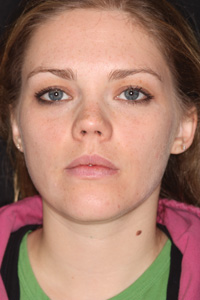 |
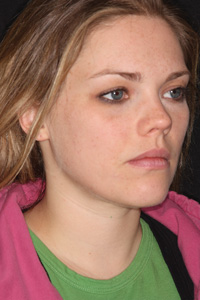 |
|
Figure 1. Full-face frontal relaxed, pre-BOTOX, first appointment. |
Figure 2. Forty-five degrees right relaxed, pre-BOTOX, first appointment. |
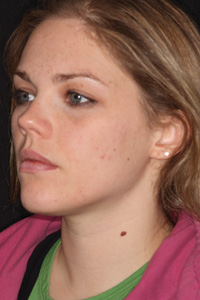 |
 |
|
Figure 3. Forty-five degrees left relaxed, pre-BOTOX, first appointment. |
Figure 4. Full-face frontal high smile with gingival display, pre-BOTOX, first appointment. |
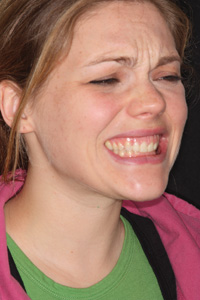 |
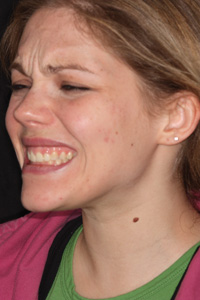 |
|
Figure 5. Forty-five degrees right high smile with gingival display, pre-BOTOX, first appointment. |
Figure 6. Forty-five degrees left high smile with gingival display, pre-BOTOX, first appointment. |
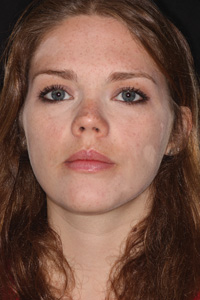 |
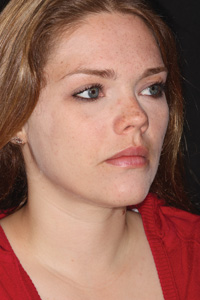 |
|
Figure 7. Full-face frontal relaxed, 5 months post-treatment with 2 units BOTOX Cosmetic with normal relaxed contour. |
Figure 8. Forty-five degrees right relaxed, 5 months post-treatment with 2 units of BOTOX Cosmetic with normal relaxed contour. |
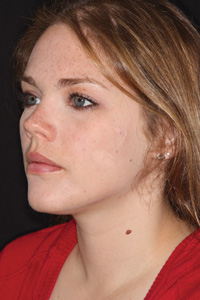 |
 |
|
Figure 9. Forty-five degrees left relaxed, 5 months post-treatment with 2 units of BOXTOX Cosmetic with normal relaxed contour. |
Figure 10. Frontal high smile, 5 months post-treatment with 2 units of BOTOX Cosmetic. Demonstrating normal gingival display. |
 |
 |
|
Figure 11. Forty-five degrees right high smile, 5 months post-treatment with 2 units of BOTOX Cosmetic. Demonstrating normal gingival display. |
Figure 12. Forty-five degrees left, 5 months post-treatment with 2 units of BOTOX Cosmetic. Demonstrating normal gingival display. |
Another example of the direct influence on other treatment the dentist is providing is seen in association with the platysma muscle. This is one of the muscles of facial expression that may have a previously unrecognized effect on gingival attachment. The muscle is often treated with BOTOX to relieve so-called “necklace lines” around the neck. It arises from the fascia covering the pectoralis major and deltoid muscles, inserting into a broad area of the mandible, the skin, and subcutaneous tissue of the lower part of the face. In a patient with fragile gingival attachment, hyperactivity of this large muscle may predispose her to gingival recession and bone loss.
TRAINING AND INCORPORATING THE SKILLS LEARNED
Our initial training in BOTOX and dermal fillers was provided by a physician colleague. Once the basic skills had been learned, the major challenge we faced was how to incorporate these skills into our dental practice. After taking any new course and learning new skills, the most difficult task is training your team to incorporate the newly learned information into your existing systems. Although challenging, this task can invigorate your team and provide stimulation for those eager to improve themselves while expanding their horizons in the art and science of dentistry.
Medical doctors and other medically trained professionals usually do not fully appreciate the effect that treatment of the upper face can have on tooth display (Figures 13 to 18). Furthermore, it is important to realize that BOTOX and dermal fillers (hyaluronic acid) have transient effects and need to be replenished at 3- and 9-month intervals respectively. Unlike medical offices, dental offices typically utilize 3- and 6-month recare appointment schedules. As a result, repeated facial rejuvenation procedures can be seamlessly incorporated into an existing recare system, thus providing patients with a discrete way of maintaining their BOTOX and dermal fillers.
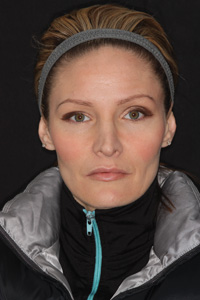 |
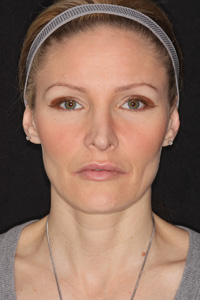 |
|
Figure 13. Full-face frontal relaxed, pre-BOTOX treatment, first appointment. |
Figure 14. Full-face frontal, 2 weeks BOTOX Cosmetic with treatment to the upper face only. |
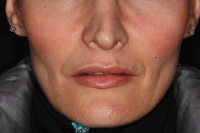 |
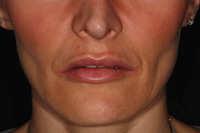 |
| Figure 15. Lower face relaxed, pre-BOTOX treatment, first appointment. | Figure 16. Lower face relaxed, 2 weeks BOTOX Cosmetic with treatment to the upper face only. Note the increased tooth display. |
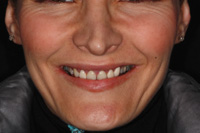 |
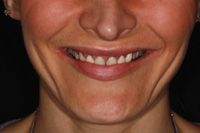 |
|
Figure 17. Lower face smile pre-BOTOX treatment, first appointment. |
Figure 18. Lower face smile 2 week BOTOX Cosmetic with treatment to the upper face only. Note the increased smile. |
Today, sophisticated patients have access to unlimited information related to their medical and dental care, thus leading to increasing aesthetic demands upon dentists by their patients. The critical relation between facial soft-tissue contours, anterior dental aesthetics and function, must be addressed. And, if the aging soft tissue aspects associated with the smile are addressed prior to any definitive dental treatment, the final restorative approach may need to be significantly modified.
The importance and effect of facial rejuvenation upon smile design cannot be overestimated and should be included into the diagnosis and treatment plan. For example, in April 2009, a research article was published linking the use of BOTOX with decreased anxiety and depression.1 In the June 2009 issue of the Journal of the Canadian Dental Association, another article addressed the current concepts in oral-systemic health2 discussing how anxiety and depression play a role in periodontal disease. Recognizing the connection between BOTOX and anxiety and depression, should we be researching a possible role for BOTOX in the treatment of certain periodontal conditions? As BOTOX therapy becomes more accepted in dentistry, we may find other uses for a cosmetic treatment often dismissed as unrelated to the practice of dentistry.
CONCLUSION
It is the authors’ opinion that the time has come for dentists to take a serious look at the topic of facial rejuvenation. Our patients deserve our attention to all relevant aesthetic details and to properly receive these ubiquitous treatments.
References
- Lewis MB, Bowler PJ. Botulinum toxin cosmetic therapy correlates with a more positive mood. J Cosmet Dermatol. 2009;8:24-26
- Iacopino AM. Relationship between stress, depression and periodontal disease. J Can Dent Assoc. 2009;75:329-330.
Dr. Janet Roberts graduated from the University of British Columbia’s Faculty of Dentistry and returned there to teach for 10 years. She is an alumnus of the Las Vegas Institute for Advanced Dental Studies where she studied extensively in aesthetic dentistry and neuromuscular occlusion beginning in 1998. She mentors the Foundations of Esthetic Dentistry study club, is an accreditation candidate with the American Academy of Cosmetic Dentistry, a founding member and director of the Canadian Academy of Cosmetic Dentistry, and a member of the Canadian Academy of Esthetic Dentistry. She is also the senior Canadian mentor-instructor and program director with the California Center for Advanced Dental Studies. She can be reached via phone at (604) 681-0066.
Dr. Warren Roberts practices in Vancouver, BC, Canada and graduated from the University of British Columbia’s Faculty of Dentistry in 1977. He has taken many continuing education programs including those at the World Dental Congresses and the Las Vegas Institute for Advanced Dental Studies. He is a past president of both the British Columbia’s Academy of General Dentistry and of the Fraser Valley Dental Society. He currently is member of the Vancouver and District Dental Society, the Fraser Valley Dental Society and the Canadian Academy of Cosmetic Dentistry. In addition, he established the BOTOX Study Club, the first in the world, emphasizing facial aesthetic treatment. Dr. Roberts has lectured internationally. He can be reached at (604) 681-0066, via e-mail at warrenroberts@dccnet.com, or at PTIFA.com.
Disclosure: Drs. Janet and Warren Roberts co-founded the Pacific Training Institute for Facial Aesthetics (PTIFA.com), which teaches the use and implementation of cosmetic BOTOX and dermal fillers into the dental office. They have developed a 2-day intensive hands-on course for dentists and their team.





